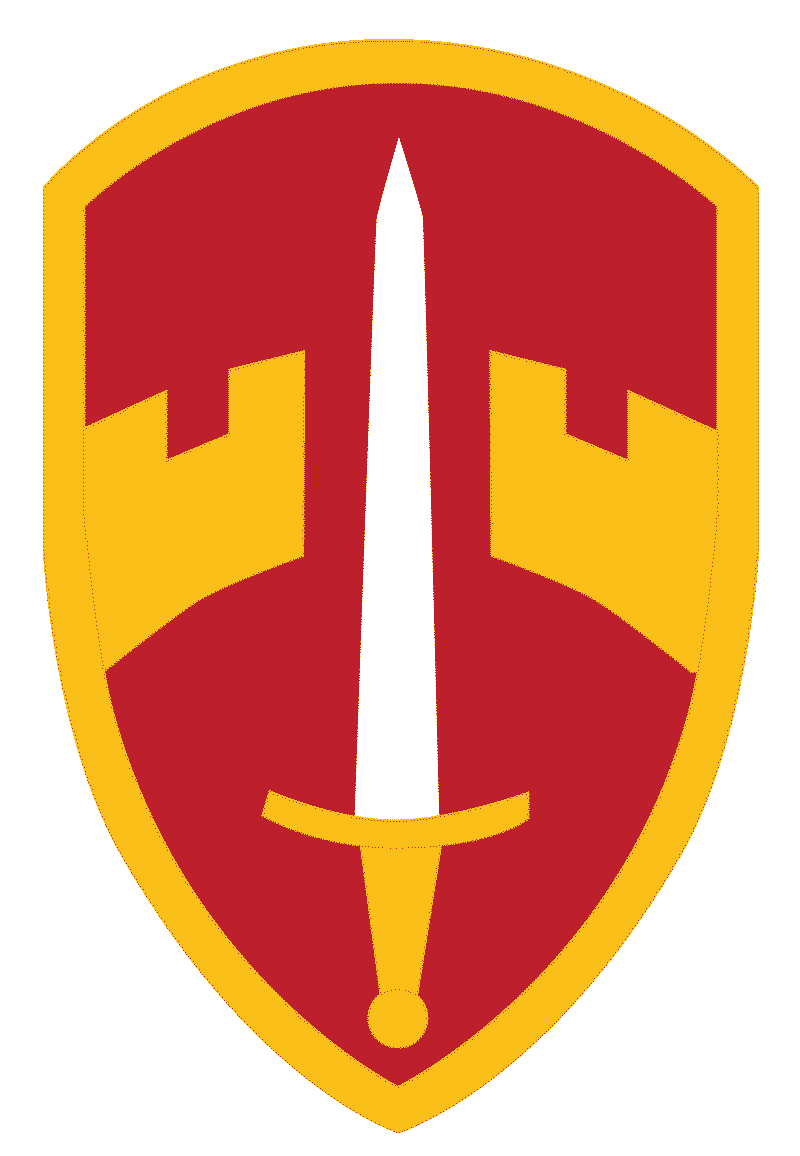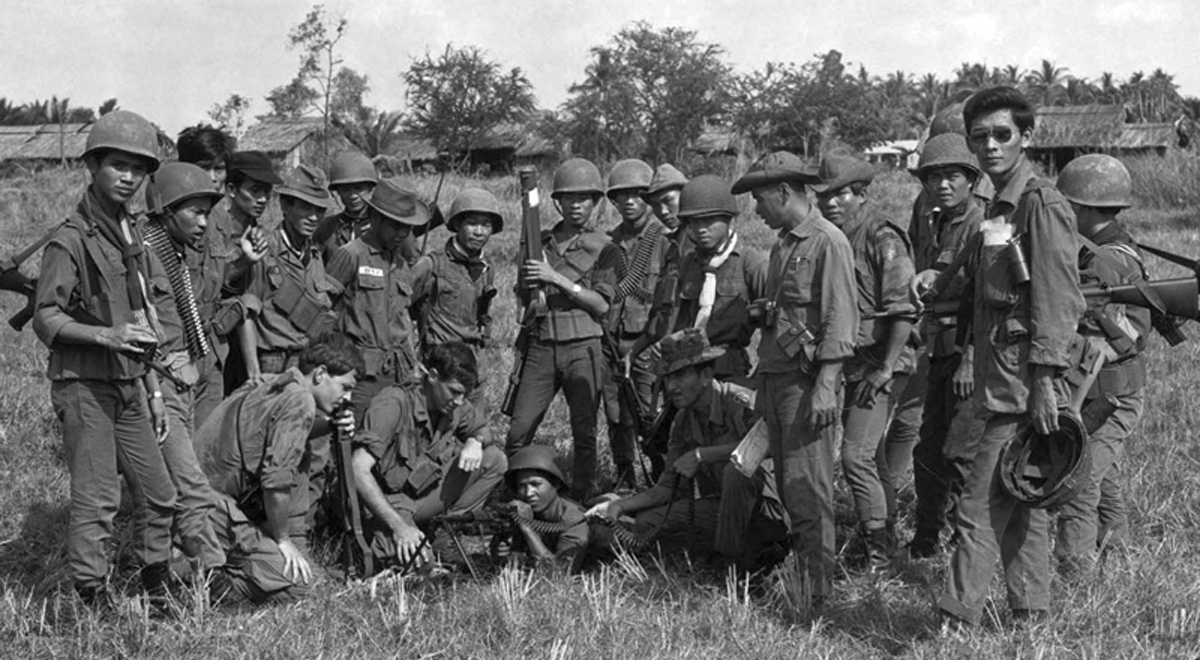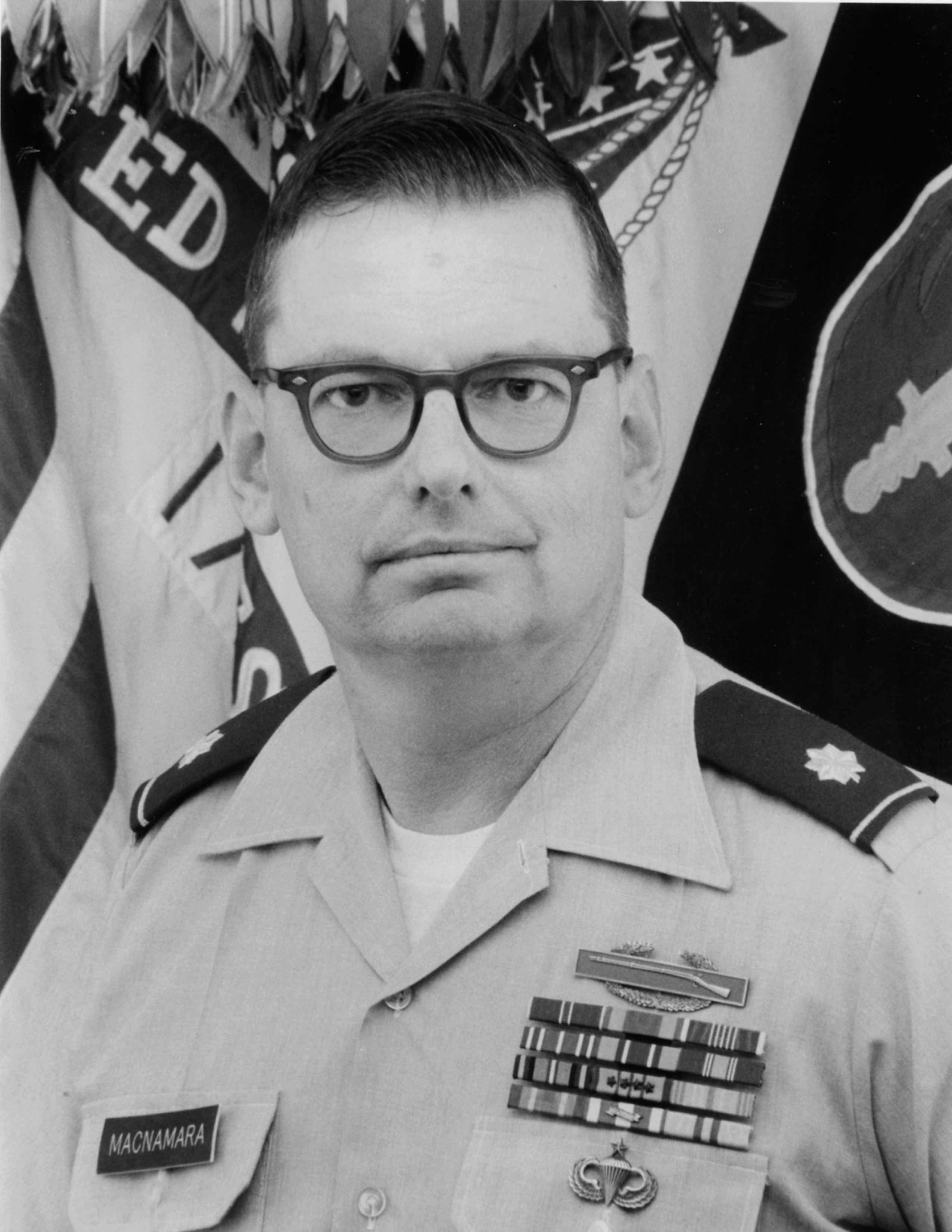MAT
(Mobile Advisory Team)

By Gary L. Macnamara LTC, IN USAR (R)
Originally published in the March 2016 Sentinel
Many of us are familiar with the war in Vietnam through books, magazines and movies. We have seen the special operations of the Green Berets, Long Range Reconnaissance Patrols (LRRP) and the conventional Army and United States Marine units. Some even have knowledge of the Military Advisory Command (MACV) Vietnam advisors. However, very few people are aware of the MACV Mobile Advisory Teams (MAT).
With the “Vietnamization” of the War in Vietnam a need was identified for advisory personnel to assist and support the local hamlet Provincial and District militias, also known as Regional Forces (RF) and Popular Forces (PF). The size of these militias could vary from squad to company size. In 1967, there were 108 American advisors. One year later there were 2,243 military advisors. Much of this growth came from the establishment of the Mobile Advisory Teams (MAT). In I Corps Tactical Zone (CTZ) the United States Marine Corps established a similar program called the “Combined Action Platoon” organized around an infantry squad.
In October-November 1968 the 1st Air Cavalry Division (Airmobile) redeployed from northern I CORPS to III CORPS with the Division Headquarters at Phouc Vinh, approximately 60 northwest of Saigon. While at Phouc Vinh, I was assigned to the 2nd BN 5th CAV as the BN S-2. I received orders to report to the Advisor’s School at Di An (Pronounced Zi An.) on 15 Jan 69 for further assignment to a Mobile Advisory Team. The Advisor Course lasted about 16 days and we had some Vietnamese language training, weapons training on some of the older United States weapons such as the BAR, the 1919A6 machine guns and Vietnamese organization. Upon graduation we were assigned to a MAT Team. The team consisted of a Team Commander (CAPT or 1ST LT), A Team XO (LT), Senior Team Sergeant (SSG or SFC), Weapons Sergeant (SGT) and a Team Medic (E-4E-5) and a Vietnamese Interpreter.
From the Advisor’s School I was assigned as the MAT Team Leader for MAT III-15. I was assigned to III Corps Tactical Zone (CTZ) to Binh Long Province. Binh Long Province was on the Cambodian Border just north of the “Parrot’s Beak” and the “Angel’s Wing”. There were two other MAT teams assigned to Binh Long Province. From my experience as a BN S-2, I knew that there were three main infiltration routes going right through the Province following the N/S route 13 from Cambodia. The Provincial Capitol was An Loc and the other major center was Loc Ninh. MSG Roy Benavides would be awarded the Congressional Medal of Honor for his actions in 1967 near the Special Forces Camp at Loc Ninh. To the extreme south of the Province was the quiet town of Chon Thanh.
We did not have too many camps, only three small compounds that I can remember. I had one assignment outside Loc Ninh where we had no compound within which to lay our heads. We were advising a Popular Force squad. One of their missions was to provide security for the village square while the villagers watched the Government of Vietnam television program. This particular squad was very good and often made contact with local VC forces. On one night the VC tried to booby trap a house but I called in mortars from the Los Ninh Special Forces camp and the enemy fled. I blew the 4.2” mortar round, upon which they had been working, in place. It would have been devastating if we had occupied that house. Later I found out that there was a 10,000 piaster reward on our heads for any American advisor.
At the village level MAT teams could also provide real time and updated intelligence to assist in rating village security. The Hamlet Evaluation System (HES) was probably one of the major weaknesses in the entire advisory effort. Once a village was deemed secure, the HES rating rarely changed. Since many Province and District advisors were on six to eight month tours, how could they report that their villages were less secure on their watch? It might reflect poorly on an efficiency report. On the other hand, as a MAT team leader, I had to deal with the denial. LTC Corson, USMC, wrote a fine book on this subject called The Betrayal.

A Regional Forces (RF) platoon receives training on an M60 machine gun from Mobile Advisory Team (MAT) personnel. (Texas Tech University Vietnam Virtual Archive)
Since we were advisors, we attempted to get the Vietnamese logistics system to work for the supported units. Many things could be had in Vietnam for a price and logistics was part of that trade. Our team bartered, traded and appropriated what we needed to supply our mission and our counterparts. The 1st Air CAV Division had a logistics base at Quan Loi and we were frequent visitors to their logistic sites, in uniforms with no names and no insignia. We scrounged food, ammunition, claymore mines and whatever else we needed to accomplish the mission.
One of my assignments was to Village 5, one of the most northernmost outposts still in Vietnam before one reached Cambodia. My immediate superior was the District Advisor at Loc Ninh, MAJ Pena, AD ( that is right Air Defense). I advised the Major that I would be outside US artillery range should I need help. I was informed that the Vietnamese artillery would shoot for me. Despite my best efforts I was unable to convince him that it was unsafe not to have US artillery in support. There are certain times when you play “you bet your bars” and this was one of them. I went to the Province Senior Advisor, Richard Parkinson, and voiced my concerns. Fortunately he agreed with me and the 1st CAV moved a battery of 105 mm howitzers to Loc Ninh.
On the first night in Village 5 with a Regional Force company in their small compound, we were attacked with a 107 MM rocket from NVA/VC forces. The rocket exploded in a tree in front of the old French rubber plantation overseer’s house and a number of Vietnamese were wounded. The RF “company” had their families with them and our first task was to med-evac the wounded soldiers and family members from a landing zone in the town square. My team Sergeant provided security on the other side of the town square. Three days later I had 10,000 sandbags filled and two bunkers with steel planking in the overhead. I also had chain link fence deployed around the building to detonate any RPG rounds. We also had another unpleasant surprise. Nominally my counterpart had 100 men in his company, but despite my effort and my team Sergeant’s efforts we could not come up with a count over 60. My counterpart was collecting the pay for 100 men and only had 60 on site. This type of corruption was not uncommon.
Despite the recent attack and the shortage of men in the perimeter, we coordinated for some local patrols and made contact with the US unit in the area, the 11th Armored Cavalry Regiment (ACR), then commanded by COL Patton (General George Patton’s son). The 11th ACR made major contact with an enemy force just north and west of our position. The area was comprised of rubber plantations so visibility was good and we could maneuver. Unfortunately if we destroyed any rubber trees, we had to reimburse the French plantation. My counter-fire on our first night must have cost the US government some money for rubber trees but the 36 rounds of artillery also resulted in blood trails. A few days after this attack I was able to arrange a MEDCAP and food distribution for the villagers. The 11 ACR provided medics to examine the villagers and left-over “mermited” food was distributed to the villagers. If one wants to develop rapport, just feed their children. I never worried about betrayal from the villagers.
In March 1969 while I was on R&R in Thailand, MAT III-13 “borrowed” my interpreter, Tony Nguyen. Tony was the best interpreter in the province. The next morning I planned to get Tony back. Unfortunately tragedy struck. We saw tracers and heard gunfire coming from the south near Chon Thanh. Tony and four members of the team were on site. We saw Cobra helicopters fire suppressive fire. The radio transmissions were not very encouraging. There weren’t any. A reaction force was ordered to the compound but never made it. We later learned that both LTs, one sergeant and Tony were killed, when gasoline bombs were thrown into their bunker. For some reason their counterpart had sold them out. Our teams were pulled in to the Province compound but redeployed after two weeks. My next assignment was to an RF company on a bridge between Loc Ninh and An Loc. Each morning a road clearing operations was conducted to make sure the road had not been booby-trapped. Often our team got their mail thrown out the window of a “Bird Dog” aircraft. As dangerous as this assignment was I was able to call in defensive artillery concentrations very close to our positions. Somehow we survived this and other assignments.
Since we lived with the Vietnamese and literally worked beside them we developed some good relationships. The War was much more personal for us. We were “Co Van My” – American advisors. In the mornings I would conduct a walk around the small compound to see if there were any breeches in the fire. There was a little Vietnamese boy named Moui, who would take my hand or I would put him on my shoulders as I made my rounds. I often wonder what ever happened to him. When one separates out the politics, it is about people and their desire to be free. Upon reflection this was part of my motivation for joining Special Forces. Our motto says it all, “De oppresso Liber.”
To the officers and men of MAT III-13, I dedicate this article.
Editors note: Click on this link to learn more about the Mobile Advisory Teams
About the Author:
Lieutenant Colonel, Infantry, USAR (retired) Gary L. Macnamara currently serves as the secretary for Chapter 78.
Gary Macnamara completed his first combat tour in the Dominican Republic in 1966, serving as a new second lieutenant with the 82nd Airborne Division. He later served in Vietnam. Gary was a company commander in both the 1st Cavalry Division (Vietnam) and Special Forces.
Beside a twenty-eight-year military career, Gary Macnamara retired from the Los Angeles Police Department as a lieutenant after serving for over 35 years.
LTC Gary Macnamara is a long-standing member of SFA Chapter 78 and has devoted significant time and energy to various projects since he joined the chapter.
Gary has played a significant role in two major chapter activities: the Green Beret Shooters Cup and the Reserve Officer Training Candidate Program at California State University Fullerton.
In 2010, at the inception and design of the Green Beret Shooters Cup, LTC Macnamara began by implementing a combat pistol and safety course to train members of the CSUF ROTC Pistol Team that were to compete in the first GBSC. He garnered the necessary firearms, ammunition, and safety officers to conduct this course to help develop the necessary skills and safety of cadets who were to compete against members of the law enforcement community and the military. He was successful, and many of these ‘students’ outscored the professionals. Because of this success, he continued the program for the following two years of the competition.
At the start of the second year of the GBSC, Gary designed and implemented a civilian competition to raise further funds, which were donated to the Green Beret Foundation. During this event, he worked as safety officer and scored the competition. This side event alone brought in several thousand dollars.
Soon after joining Chapter 78, Gary volunteered to attend and represent Chapter 78 at the annual ROTC Awards Program, where he presented SF Medals and Certificates and later a monetary donation to members of the CSUF Cadets. He developed a working relationship with the Professor of Military Science and was initially asked to teach a military history class. Over the course of a semester, with excellent reviews of his teaching ability and knowledge of historically significant military subjects, he was asked to begin teaching a series of subjects to the CSUF ROTC Cadets. Gary continues as a volunteer adjunct lecturer of Military History for CSUF. He uses his background in Special Warfare and Unconventional Warfare as a Special Forces-qualified officer to assist both the Professor of Military Science with Battle Analysis, Military Ethics, and Problems with Command and the Primary Military History Instructor with classes on the Mexican-American War, Civil War, World War II, Korea, Vietnam, and any other classes.

Gary Lewis MacNamara
Gary L. Macnamara
I thoroughly enjoyed your article! It was all very familiar. Glad you made it back, and prospered.
This is an excellent bio sir. I lead a MATS Team at Xuan Loc on the LgaNa River not far from Dian. We experienced much of what of what you depicted. The only real problem I had to deal with was my E-7 Wpns Sergeant. He was very knowledgable
but had a drinking problem. Fortunately I was able to get the team to work with him and the brief 3 months he and I worked together turned out ok, before he derosed.
I actually learned a lot a great deal at at the six month point I was assigned to the Phoenix Program in Saigon due I was told to my Special Forces background. It was not a desk job